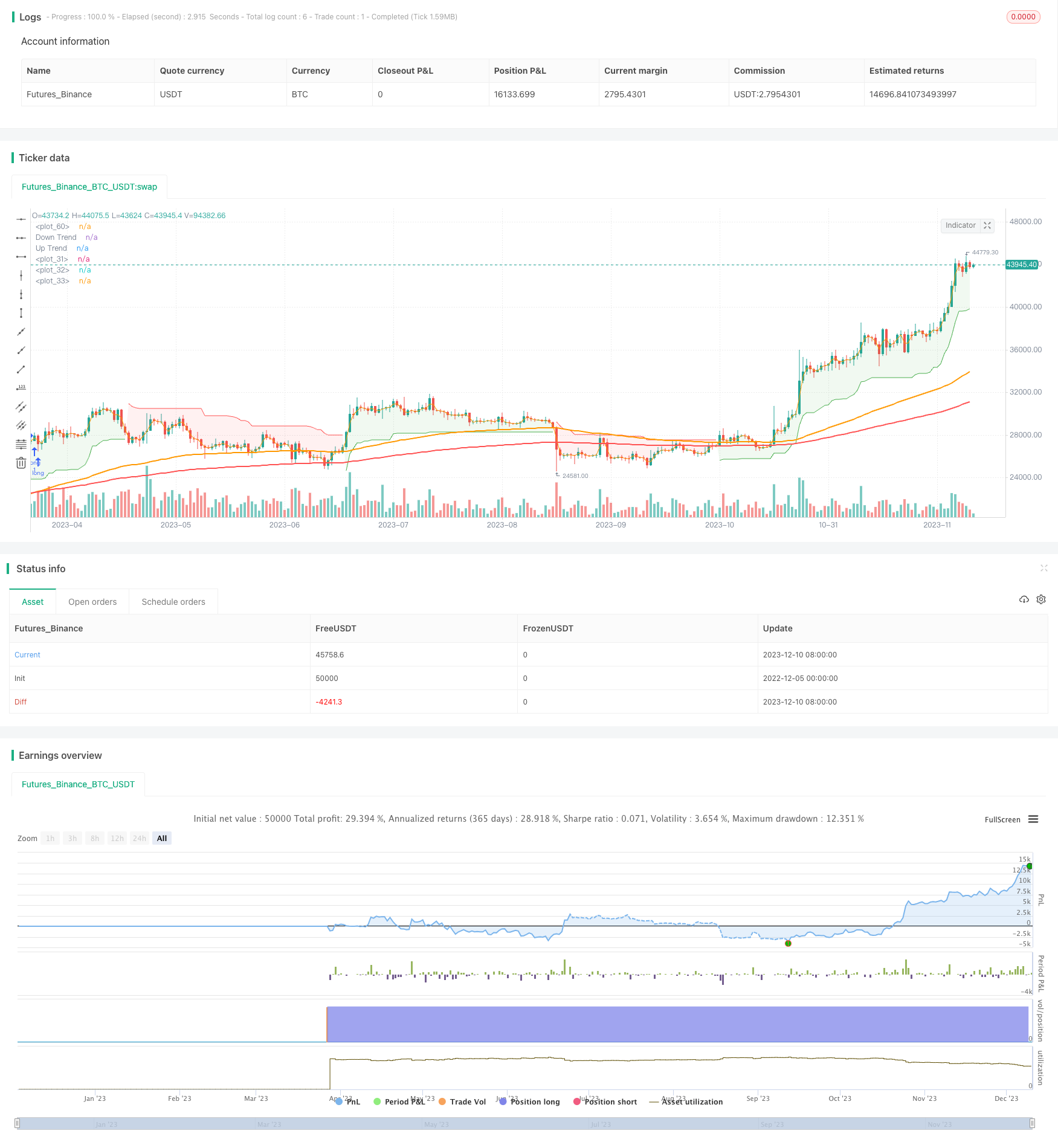
概述
该策略基于移动平均线交叉和ATR指标来实现自动化的趋势跟踪交易。当快速EMA线上穿慢速EMA线时,采取做多头仓位;当快速EMA线下穿慢速EMA线时,采取做空头仓位。同时,结合ATR指标来判断趋势方向,只有在ATR判断为趋势方向时才发出交易信号。
策略原理
该策略主要基于两个技术指标:
EMA均线:采用快慢两个不同参数的EMA均线,当快线上穿慢线时视为多头信号,下穿时视为空头信号。
ATR指标:ATR指标能够判断价格波动的幅度和力度, 从而判断当前走势的趋势性。当ATR数值较小时表示目前处于盘整,此时不宜建仓;当ATR数值较大且方向向上时,表示目前处于趋势市,此时等待EMA金叉做多;当ATR数值较大且方向向下时,表示目前处于趋势市,此时等待EMA死叉做空。
通过EMA均线的交叉来寻找买卖点机会,同时结合ATR指标来过滤掉趋势性不强的交易信号,避免在市场震荡盘整中被套牢。
优势分析
该策略具有以下优势:
只在ATR指标判断为趋势行情时才交易,有助于避免震荡不明时被套牢。
运用快慢均线的交叉原理寻找买卖点,简单有效。
通过参数调节,EMA均线的敏感度和平滑性可以根据个人喜好进行调整。
只需要利用两个简单指标即可实现的完整的自动交易系统,可以轻松地通过Pine编辑器进行策略开发与优化。
无需频繁调整的参数,实现简单的ParameterSet和Forget策略。
风险分析
该策略也存在一些风险需要关注:
EMA交叉容易产生假信号,可能引发不必要的亏损。可以通过调整EMA参数平滑一些指标。
ATR指标有时对盘整和趋势的判断也可能有失误,从而导致错过交易机会。可适当宽松ATR的数值门槛。
策略本身没有考虑大级别因素分析,如果遇到重大消息面市场出现反转,则很难通过快速均线交叉判断,这时需要人工干预装逃顶底。
可以通过一定的优化来降低这些风险的影响。
优化方向
该策略还有以下几个主要的优化方向:
可以考虑加入其它指标判断,形成指标组合系统,提高信号的准确性。例如结合RSI指标避免超买超卖的风险。
可以根据不同交易品种、不同交易区间来选择更合适的参数,使EMA和ATR的参数更符合当下市场特点。
可以通过机器学习等方法实现动态参数优化。让指标参数可以根据实时市场情况进行调整,而不是使用固定静态的数值。
总结
本策略整体是一个非常实用的趋势跟踪策略。只需要两种简单指标的组合就可以实现较为完整的交易系统。通过参数调节可以适应不同偏好的交易者。同时也具有进一步扩展优化的空间,使策略表现更加出色。简单高效的交易思路与良好的优化潜力,使其成为值得长期研究与应用的量化策略之一。
/*backtest
start: 2022-12-05 00:00:00
end: 2023-12-11 00:00:00
period: 1d
basePeriod: 1h
exchanges: [{"eid":"Futures_Binance","currency":"BTC_USDT"}]
*/
// This strategy has been created for GMT trade 4h by Zhukov
//@version=5
strategy('ZhukovTrade', overlay=true, calc_on_every_tick=true, currency=currency.USD)
// INPUT:
// Options to enter fast and slow Exponential Moving Average (EMA) values
emaFast = input.int(title='Fast EMA', defval=100, minval=1, maxval=9999)
emaSlow = input.int(title='Slow EMA', defval=200, minval=1, maxval=9999)
// Option to select trade directions
tradeDirection = input.string(title='Trade Direction', options=['Long', 'Short', 'Both'], defval='Both')
// Options that configure the backtest date range
startDate = input(title='Start Date', defval=timestamp('01 Jan 2023 00:00'))
endDate = input(title='End Date', defval=timestamp('31 Dec 2023 23:59'))
// CALCULATIONS:
// Use the built-in function to calculate two EMA lines
fastEMA = ta.ema(close, emaFast)
slowEMA = ta.ema(close, emaSlow)
emapos = ta.ema(close,200)
// PLOT:
// Draw the EMA lines on the chart
plot(series=fastEMA, color=color.new(color.orange, 0), linewidth=2)
plot(series=slowEMA, color=color.new(color.blue, 0), linewidth=2)
plot(series=emapos, color=color.new(color.red, 0), linewidth=2)
// CONDITIONS:
// Check if the close time of the current bar falls inside the date range
inDateRange = true
// Translate input into trading conditions
longOK = tradeDirection == 'Long' or tradeDirection == 'Both'
shortOK = tradeDirection == 'Short' or tradeDirection == 'Both'
// Decide if we should go long or short using the built-in functions
longCondition = ta.crossover(fastEMA, slowEMA)
shortCondition = ta.crossunder(fastEMA, slowEMA)
// ORDERS:
// Set take profit and stop loss percentages
take_profit_percent = input(0, title="Take Profit Percent")
stop_loss_percent = input(0, title="Stop Loss Percent")
// Submit entry (or reverse) orders
atrPeriod = input(12, "ATR Length")
factor = input.float(3.0, "Factor", step = 0.01)
[supertrend, direction] = ta.supertrend(factor, atrPeriod)
bodyMiddle = plot((open + close) / 2, display=display.none)
upTrend = plot(direction < 0 ? supertrend : na, "Up Trend", color = color.green, style=plot.style_linebr)
downTrend = plot(direction < 0? na : supertrend, "Down Trend", color = color.red, style=plot.style_linebr)
fill(bodyMiddle, upTrend, color.new(color.green, 90), fillgaps=false)
fill(bodyMiddle, downTrend, color.new(color.red, 90), fillgaps=false)
if longCondition and inDateRange
if longOK and direction<0
strategy.entry(id='long', direction=strategy.long, alert_message = "LONG")
if shortCondition and inDateRange
if shortOK and direction>0
strategy.entry(id='short', direction=strategy.short, alert_message = "SHORT")
// Submit exit orders in the cases where we trade only long or only short
if strategy.position_size > 0 and take_profit_percent
strategy.exit(id='tp long',from_entry ="long",profit = take_profit_percent)
if strategy.position_size > 0 and stop_loss_percent
strategy.exit(id='sl long',from_entry="long",loss=stop_loss_percent)
if strategy.position_size < 0 and stop_loss_percent
strategy.exit(id='sl short',from_entry="short",loss=stop_loss_percent)
if strategy.position_size < 0 and take_profit_percent
strategy.exit(id='tp short',from_entry="short",profit = take_profit_percent)